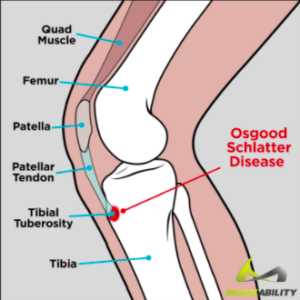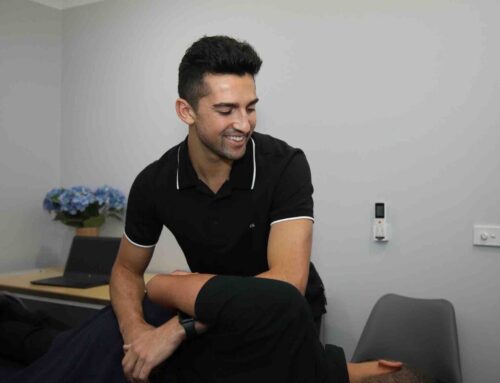What is it?

https://www.braceability.com/blogs/info/osgood-schlatter-disease
Osgood-Schlatter disease is a painful knee condition that generally affects adolescents. It involves the swelling and irritation of the growth plate located at the top of the shinbone. A growth plate is a layer of cartilage close to the end of the bone where most of the bone’s growth happens. This condition often occurs during a growth spurt and goes away when the child stops growing and usually doesn’t cause lasting problems.
What are the Symptoms?
Osgood-Schlatter typically causes pain and swelling below the kneecap on one or both legs. The pain generally gets worse with running, jumping, going up stairs and walking up hills. When the pain is really bad, it may lead to limping. Over time, there may be a palpable lump under the knee where the bone regrows as a stress response to this condition.
How Does it Happen?
As you grow, especially in a growth spurt, your bones, muscles and tendons grow at different rates. In Osgood-Schlatter disease, the tendon (a structure that connects bone to bone) that attaches your kneecap to your shinbone can pull on the growth plate. Activities and sports that repetedly cause this can result in the pain of Osgood-Schlatter disease.
Kids who are active and engage in athletics and sports are at increased risk. Research shows that boys are generally more commonly affected but it may be because they tend to play more vigorous sports.
How is it Diagnosed?
 Health care providers will use a health history and physical examination to diagnose this condition. Usually, no testing is required as Osgood-Schlatter disease cannot be seen on x-rays, however healthcare professionals may order them to rule out other problems.
Health care providers will use a health history and physical examination to diagnose this condition. Usually, no testing is required as Osgood-Schlatter disease cannot be seen on x-rays, however healthcare professionals may order them to rule out other problems.
How is it Treated?
- Limiting the activities that cause the pain is important. It is okay for there to be a little bit of pain but if the pain causes the child to limp, then they should stop and rest. Usually after a day or two when the pain is better, the child can try the activity again.
- If there is a flare up, you can put ice or a cold pack just below the knee for 5-10 minutes every 1-2 hours to decrease pain.
- Stretching and strengthening exercises which can be provided by an osteopath for the calf muscles, hamstrings and quadriceps may help in reducing pain.
- Taping or a patella brace may be used to help offload the irritated shin bone to allow the area to heal.
- Medications, such as painkillers and anti-inflammatories may be prescribed by your doctor or pharmacist to aid in pain relief.
- Time – the most important thing. Generally, the pain will ease in two weeks, but it can take up to 2 months. The growth plate can take up to 2 years to mature (sometimes longer), which means there may be flare ups from time to time. These can be triggered by growth spurts, changes in sporting activities, changes in footwear or changes in surface.
If you have any further questions, feel free to email me at niraj@pakenhamosteopathy.com.au, or if you would like to book a consult, feel free to call Pakenham Osteopathy on 5941 4157.
References:
Nemours KidsHealth. (2019). Osgood-Schlatter Disease. Retrieved from: https://kidshealth.org/en/parents/osgood.html
Better Health Channel. (2015). Osgood Schlatter Syndrome. Retrieved from: https://www.betterhealth.vic.gov.au/health/conditionsandtreatments/osgood-schlatter-syndrome
Osgood-Schlatter’s Disease. (2021, October 31). Physiopedia,. Retrieved 02:16, November 14, 2021 from https://www.physio-pedia.com/index.php?title=Osgood-Schlatter%27s_Disease&oldid=284506.




